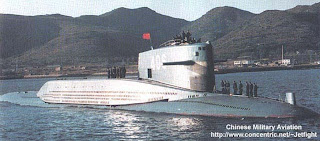30 November 2009
The Chinese Navy appears to be stressing quality over quantity as it
modernizes its submarine force, according to a U.S. Navy intelligence
report. But China still has a way to go on quality. Some of its newest
submarines are as noisy as subs built decades ago.
Nuclear-powered
Jin-class ballistic missile submarines are designed to give China's
naval force, known as the People's Liberation Army Navy (PLAN), "a
credible second-strike capability," the U.S. Navy said in an August
intelligence report that surfaced briefly on the Office of Naval
Intelligence Web site, then vanished. The report was captured and
published by the Federation of American Scientists.
The Jins -
there are two in service - are more advanced than China's
first-generation Xia ballistic missile submarines, but they're not
exactly stealth machines.
According to a chart in the U.S. Navy report, Jins are louder than Soviet Delta III submarines built 30 years ago.
That
raises questions about just how useful the submarines might be as a
deterrent, said Hans Kristensen, director of the Nuclear Information
Project at the Federation of American Scientists.
Second-strike
capability is intended to cause adversaries to refrain from attacking
because whoever has second-strike capability can counterattack. But
putting ballistic missiles on noisy submarines might not be an
effective second-strike strategy.
"If these are clunkers that you
can hear all the way to Hawaii," they are likely to be quickly found
and sunk in any conflict with the U.S. or Russian navies, Kristensen
said. "With this noise level, they're very detectable."
A new
Chinese nuclear attack submarine called a Type 095 rates better on the
U.S. Navy's noise scale, but it is still louder than a 20-year-old
Soviet-designed Akula attack sub, according to the Navy chart. The 095
submarines are expected to begin entering the Chinese fleet in 2015.
Even
if they are noisy, they are not as noisy as the Han- and Shang-class
nuclear attack submarines that came before them, the intelligence chart
shows.
This is apparently the first time a U.S. Navy description
of the noise levels of modern Chinese and Russian nuclear submarines
has been made public, Kristensen said. The report is titled "The
People's Liberation Army Navy: A Modern Navy With Chinese
Characteristics."
Threat or Not?
There
are two ways to interpret the U.S. Navy's data, a U.S. government naval
expert said. One is that China's noisy submarines are inferior to any
in the U.S. fleet, and therefore not much of a threat. The other is
that the new subs demonstrate that Chinese submarine technology is
getting better, and loud though they might be, Chinese submarines are
getting quieter.
And real performance in the ocean is "not quite
as one-dimensional as the Navy's chart depicts," he said. China's
submarines can be quieter under certain operating conditions.
On
the whole, however, the new Chinese submarines are "not anything at
this point that we should panic over in terms of detecting and tracking
them," he said.
According to the U.S. Navy, China currently has
three nuclear-powered ballistic missile submarines, six nuclear-powered
attack submarines and 53 diesel-electric attack submarines.
This
62-sub fleet is expected to grow to about 75 by 2020 or 2025 as new
submarines, including non-nuclear air independent propulsion vessels,
are added to the fleet.
The intelligence report also predicts
that all of China's new attack submarines will probably be armed with
advanced cruise missiles. Today's attack submarines are armed with
anti-ship cruise missiles, wake-homing torpedoes and mines, according
to a Nov. 23 report by the Congressional Research Service.
China's
Jins are designed to carry 12 JL-2 nuclear-armed ballistic missiles
with a range of 3,888 nautical miles, according to the U.S. Defense
Department's annual Chinese Military Power report.
The Naval
Intelligence report said that with Jin-class submarines and JL-2
ballistic missiles, "China is developing a near-continuous at-sea
strategic deterrent." The missiles are "capable of reaching the
continental United States from Chinese littorals," giving the PLAN "its
first credible second-strike nuclear capability."
Kristensen said he's not convinced.Citing other Defense Department numbers, he said missiles fired from Jin-class submarines in Chinese waters "would fall into the sea about 800 kilometers [about 500 miles] from Seattle."
"With the range this
system has, it is not a system that can target the United States unless
they sail well into the Pacific," Kristensen said. "I'm very puzzled
about why the Chinese would be putting their crown jewels - JL-2
missiles - on submarines that are that vulnerable."
Using Jin
submarines only makes sense as a deterrent "if they survive. And a
blunt claim would be that they would not survive in a war with the
United States," he said.
The Jin and its missiles appear to be "a regional weapon," that could threaten Japan or U.S. military assets on Guam, he said.
Perhaps
the Jins are not intended to be a deterrent against the United States.
Their missiles might be intended to deter Russia, which has a history
of border tensions with China, Kristensen said.
India also may be
a target for Chinese deterrence. India has nuclear weapons, but as yet,
none that can strike as far as China, he said.
Or perhaps the
submarines and their missiles are intended as a display of national
pride, he said. When nations become military powers, one of the things
they do is build ballistic missile submarines, Kristensen said.
Lt. Cmdr. Billy Ray Davis, a U.S. Navy spokesman, said no one was available to answer questions about the report.Original News









